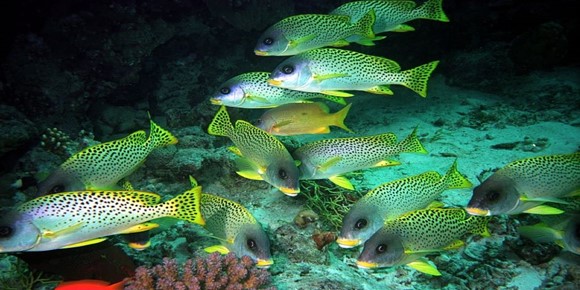Overview
Far offshore from the mainland coast and far from other reefs, Qita 'el Banna rises like a needle from the seabed more than 400 meters deep. It has an oval shape and the reef top reaches just below the water surface. Two small, beautifully overgrown plateaus are located on the north and southeast sides. The sides of Qita 'el Banna drop off steeply. Steep wall divers get their money's worth here.
Description
The southeast side
The highly rugged reef wall is overhanging in places on the upper 15 meters. Many small canyons have formed along the wall where soldier fish seek cover. The diver may encounter groups of giant sweetlips moving along the slope - an attractive subject for underwater photographers.
At the southern end of the wall, a slope extends to a depth of 40 meters. Below it lies a large cave. On the partly sandy bottom of the cave rest whitetip reef sharks. Colorful coral formations and the seemingly bottomless depth captivate the visitor. However, it tempts to forget about time and depth. Due to the numerous schooling fishes, such as vermillion seabass, and the many small caves, the shallower area also has a lot of interesting things to offer.
West side with north plateau
The west side drops steeply to a depth of over 70 meters. The steep drop is interrupted at a depth of 40 meters by a small plateau. Similar to the east side, the reef wall is strongly cragged on the upper 10 meters, where small caves have formed. In these, various coral dwellers can be spotted.
Shoals of reef fish, such as doctor fish or yellow head snapper, move along the entire reef wall. Large gorgonians stretch their fans into the current to filter out planktonic organisms from the water.
At the north end of Qita 'el Banna is a small plateau covered with coral heads. It begins at a depth of 10 meters, descends gently and ends at its outer edge in a steep wall. If the diver looks at this edge into the depth or into the open water, there is a good chance to spot large pelagic marine life.
Hotspots
- Single big barracudas make their circles and on the sandy bottom sometimes whitetip reef sharks are resting.

 ENGLISH
ENGLISH
 РУССКИЙ
РУССКИЙ
 DEUTSCH
DEUTSCH

